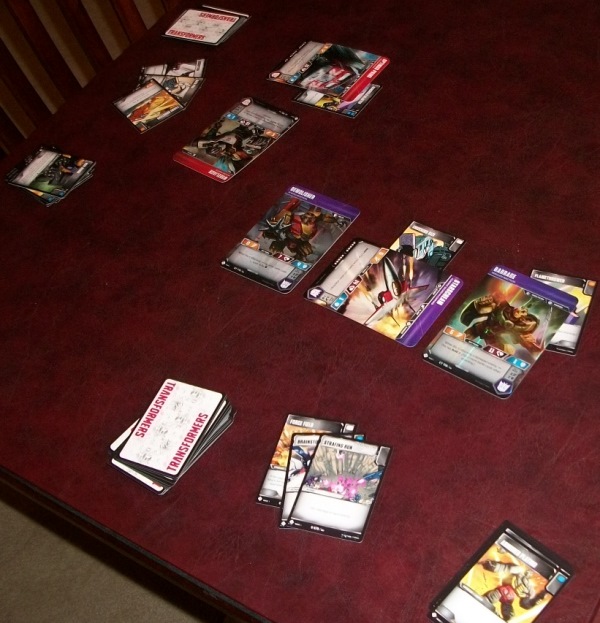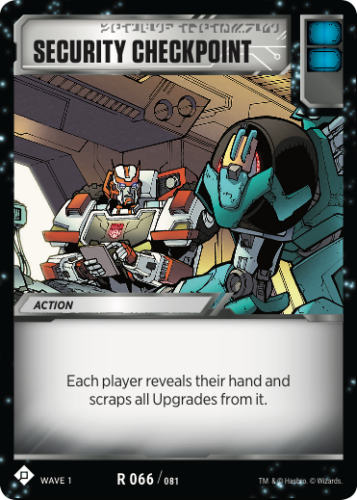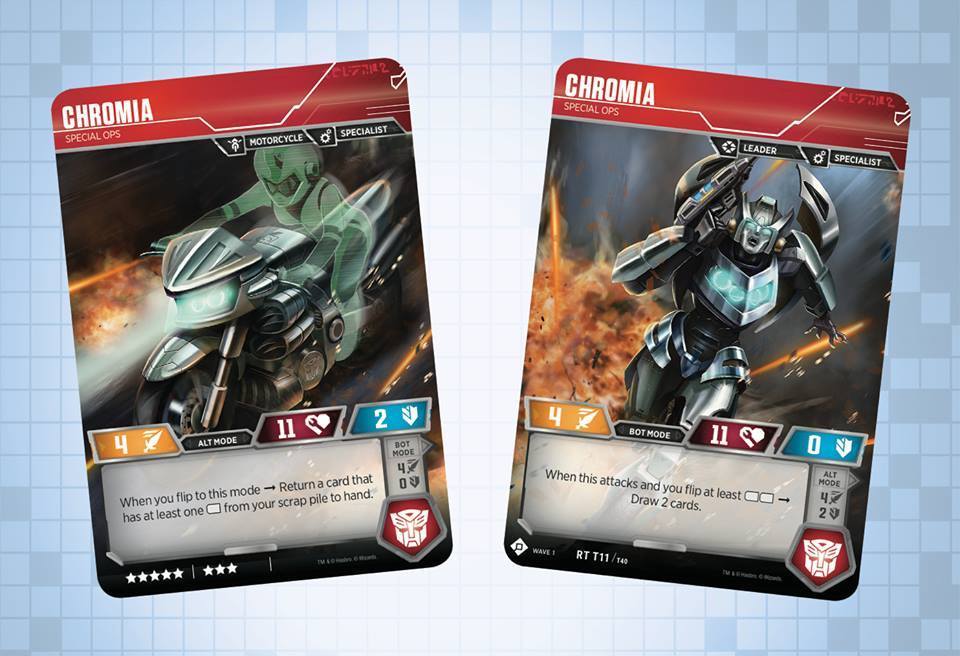 Transformers:
TCG Wave 1 & Metroplex Set Review
Transformers:
TCG Wave 1 & Metroplex Set Review
Starter Set Release Date & Price:
September 28, 2018; $15 U.S.
Booster Pack Release Date & Price:
September 28, 2018; $4 U.S.
Metroplex Set Release Date & Price:
November 16, 2018; $20 U.S.

As opposed to "one release
and then done" Transformers card games Hasbro has released in very limited
quantities (and with very limited/shallow play value) over the years, in
2018 Hasbro revealed a Transformers collectible card game with a good amount
of effort put behind it (albeit reused art from either mobile games or
the IDW comics), with the mechanics masterminded by Wizards of the Coast
legends, including some that even are responsible for Magic: The Gathering.
Because of this, I decided to overcome my initial skepticism about these
kinds of licensed card games and bought a good portion of the first "wave/assortment"
of Transformers: The Card Game (TCG) product. Before I get to how I feel
about the game, though, it's necessary to give an overview of how the game
works.
First, you have your
Transformers cards, which are put out at the start of the game in their
alternate mode-- these are bigger than your average cards, and are double-sided,
with their alt mode on one side and their robot mode on the other (which
is foil-stamped). Since you put them out at the beginning of the game,
there's no secrecy regarding your TFs-- these are your "soldiers", as it
were. If you KO all of your opponents' Transformers, you win the game.
There is a "star" rating attached to each Transformers card-- as low as
5, and as much as 12 or 13 for the strongest TFs, so you can decide whether
you want to go with several weaklings or a few big tough guys, with 25
stars being the maximum combined value your Transformers can have. Autobot/Decepticon
allegiance doesn't really matter much except for a few select cards here,
so having a mixed group of both sides in play on one side is common. What
matters more are various traits applied to each TF, such as "Melee", "Ranged",
"Jet", "Leader", "Dinobot", and the like. Various special abilities and
cards apply only to certain Transformers, and can only be applied to the
Transformer that has that trait in the mode they're in (though once they
have an "upgrade", they can keep it regardless of which mode they're in).
Each Transformer has an attack value, a defense value, and a number of
hit points (HP). The attack and defense values can change depending upon
which mode the Transformer is in, but the HP never changes. Many TF cards
also have unique/different special abilities in each mode.
As with most card games,
you also have a deck with smaller cards that all look the same on one side,
and draw them blindly and keep them in your hand. (Due to the gameplay
mechanics, usually hands are relatively small in this game-- I rarely went
above 4 cards in my hand at one time.) These are called "battle cards",
and are divided into two different categories-- Actions and Upgrades. Actions
are simply effects that take place the moment you play them, while upgrades
are attached to Transformers and give them a temporary or permanent upgrade,
such as +2 attack. Each Transformer has three upgrade "slots"-- one for
each of the kinds of upgrade cards, which are Armor (usually affect Defense),
Weapon (usually affect Attack), and Utility (effects vary wildly). During
most turns, you draw a card, play an action and an upgrade (if you want),
transform one of your TFs (again, if you want), and then attack with one
of your TFs. To vary things up from a simple "subtract the defense from
the attack" formula and keep things more interesting, both the attacking
and defending player (normally) flip the top three battle cards on their
decks. Beyond simply a picture, title, and description, most battle cards
have "pips" of one of three colors in the corner-- orange, blue, or white
(some have more than one "pip" of the same color, or "pips" of multiple
colors). For however many orange pips you draw during this stage, you add
that much to your attack if you are the attacker. For however many blue
pips you draw, you add that much to your defense if you are the defender.
If you draw any number of white pips, you can draw an ADDITIONAL three
cards and add up those additional orange/blue pips to your total, but this
ability with white pips only works once an attack/defense. This adds considerably
more variety and keeps things interesting while also adding your standard
amount of strategy/luck to the game. (For example, if you want an offense-heavy
deck, you can add in a lot of cards with orange pips in the corner.) After
the damage is counted, the drawn cards are discarded, their text not counted
for the purposes of these draws. Only for the cards you draw in your hand
are you to carry out what it says on the card when you play it. (And, in
contrast, if you play a card like normal during your turn, the different-colored
pips are ignored.)
Once a Transformer has
attacked, they are turned sideways, or "tapped". It can't attack again
until it's untapped. Then it's your oppponent's turn, and a Transformer
must attack Transformers that are tapped unless all Transformers are tapped/untapped,
in which case you can pick any one. (There are obviously cards that get
around this. It should also be noted that you don't HAVE to attack during
your turn, but it's almost always beneficial.) Once each opponent has tapped
all of their Transofrmers, all TFs are untapped on the next turn and play
continues back-and-forth until one player's TFs are defeated. With 25 stars
usually meaning 2-4 Transformers per player, games are usually over within
5-20 minutes, depending on how effective the players are against each other
and how familiar they are with the game; this isn't like Magic where the
games can go on for hours, allowing you to change your line up relatively
frequently and get in multiple games in one relatively short sitting. Each
battle deck can consist of a minimum of 40 cards, with no more than 3 of
the same card in each. If you run out of your deck, you simply re-shuffle
it-- there is no penalty for drawing all of your cards, so it's normally
in your best interest to make your deck as small as possible to limit the
randomness of your draws. As of Wave 1, this game is solely made for 2
players-- no big 4-player showdowns or anything of the sort, here. (There
is nothing in the rules outright it making impossible to have more than
2 players, but there's nothing that can prevent unfair teammups in those
situations.) Of one final note here is that you will need some kind of
tokens to serve as damage counters-- the Starter Set and Metroplex Set
come with some little paper pieces with numbers on them, but they're flimsy
and often not quite enough for games.
As for what packs contain
which, the Starter Set contains unique Bumblebee, Ironhide, Red Alert,
and Optimus Prime cards, along with 80 cards, enough for 2 identical decks.
The Starter Set is exactly what it says, in the sense that it's meant to
introduce you to the very basic rules of the game. Ironhide and Red Alert
have no special abilities at all, and none of the special abilities are
particularly involved. Having two identical decks also limits the customization
you can do with each. Booster packs contain 8 cards total from Wave 1--
1 Transformers card and 7 battle cards. There is always 1 rare battle card,
2 uncommon, and 5 common-- this does not apply to the Transformers card,
which can be any of those three rarities. (There are also two Transformers
cards-- Nemesis Prime and a variant of Bumblebee-- that are "Super Rare",
and have an astoundingly low 1-in-79 chance of appearing in a booster pack.)
As for the Metroplex set, this contains a unique HUGE Metroplex Titan card,
3 unique Transformers cards (Scamper, Slammer, and Six-Gun), and a deck
of 40 cards, with 3 each of 3 unique Metroplex-related cards. Basically
the twist to this deck is that Metroplex is 25 stars all by himself and
has a ton of hits, and by transforming him rapidly you can deploy any of
his 3 minions from "under" him. (Slammer is the only Transformers card
that does not transform, as the original toy was a little non-transformable
drone.) The minions can also be used individually at the start of a game
if you want, as they are the only 4-star Transformers out as of Wave 1,
but they have abilties that all tie into Metroplex and are very weak individually,
so they're very much a "well, I've got 21 stars already, let me just pick
one because it's better than nothing" option if you're placing your Transformers
out.

I was surprised as just
how well this game was crafted-- it falls very much into the "easy to understand,
difficult to master" type of card game. The rules are simple enough where
somewhat young children could play it-- Magic: The Gathering this
is not-- and yet, a lot of cleverness can be used in constructing decks.
I've already talked about stacking your deck heavily with battle cards
with orange pips if you want an offensive-heavy deck (or blue pips if you
want a defensive-heavy deck), but there's lots of other, more specific
options you can use. To take a few examples, there are several cards that
apply only to tanks-- obviously put a bunch of these in your deck if you
want tank Transformers out, and leave them out of your deck if you're using
other TF cards. Using certain Dinobot cards on your team of Dinobots can
really up their damage to rather ridiculous levels. There's also decks
you can make centered around a specific character or two-- for example,
Nemesis Prime gets stronger the more times you go through the deck, so
you'll want to stack your deck full of cards that let you discard cards
as quickly as possible to beef him up. Flamewar isn't very tough herself,
but can use her abilities to buff other Transformers, so you can use her
strategically to complememt your other TFs' weaknesses. (As a side note,
although most TF cards are A- or B-list G1 characters, I'm glad they included
a few non-G1, obscure oddities in the set like Flamewar and Deadlock.)
There are cards that can focus attacks on a certain Transformer to keep
enemies from attacking relatively weak TFs, as well. Certain combinations
of battle cards work together really well too, such as using cards that
pick up a certain amount of cards, but have you put back all but 1 of them.
This may seem a relatively tame ability at first, but this actually allows
you to "stack" your deck slightly by putting any possible white-pip cards
on top to make sure you draw them, or making your draws orange- or blue-heavy,
depending upon whether you're attacking or defending. And all these examples
just scratch the surface; I have seen some truly devastating, incredibly
clever combinations of cards used out there. Again though, you will usually
want to keep your decks as slim as possible to lessen the randomness, which
works well given that decks will often need to be customized at least slightly
for each game (unless you have enough cards where you have a ton of decks
available for every combination of TF cards you want to use).
The game is also quite
flexible. For example, although the official rules state that you use 25
stars' worth of TFs, there is nothing inherent in the game that makes that
number set in stone. If both players have enough Transformers to do 50
or even 100 stars' worth, settle in for a nice big fight and have at it.
Additionally, although with 3 players I could see things getting unfair,
theoretically (I have not done this myself) I could see 4 players working
well if you implement the "only attack the player across you" rule, and
then once the first two are out the "survivors" go at it to determine the
true winner. If you think the game is too slow or too fast for you, there's
also nothing preventing you from drawing just 1 or 2 cards for battling,
or 4 or 5 to increase or decrease the average amount of damage done in
an attack.
All this said, I do
have one beef with this game, and that's its emphasis on rarity. Rare cards
are usually (not always) better than common cards, which obviously will
reward the player who spends more on the game more than the player who
spends less. To some extent this is to be expected-- if you have more cards,
you can put together more devious combinations-- but the fact that rare
cards are, by themselves, usually better is not something I'm all that
fond of. The worst aspect of this comes to the Transformers cards, though--
as mentioned earlier, the booster packs contain 1 mere Transformer card
with 7 battle cards. Obviously you need more battle cards than TF cards
for the game, but there aren't enough battle cards to justify this. There
are only roughly twice as many battle cards in Wave 1 as there are Transformers
cards, and so you will get TONS of the exact same common (and even uncommon)
battle cards while you still only have, say, half of the total Transformers
there are. Worse, the game does not let you play doubles of a Transformer
(here defined as including both the Transformer name AND the description--
for example, there are multiple versions of Optimus Prime, with various
abilities and rarities. You can theoretically have more than one Optimus
Prime out-- but one has to be "Optimus Prime, Autobot Leader", another
"Optimus Prime, Legendary Warrior", and so forth. You cannot have two "Optimus
Prime, Autobot Leaders" in play by the same player). This means that if
you get a double of a Transformers card you already have, that card is
literally of no value to you except as trade fodder. Thus, if you open
a pack that has a Transformers card you already possess-- unless you get
a REALLY nice rare battle card, it's essentially a waste. Even the rarest
battle cards go for only a couple of bucks on eBay, while multiple rarer
TFs push past $20, and the super rares (Nemesis Prime in particular) commanding
some truly insane prices. It's clear that Transformers cards are what people
really want, and you cannot get more than 1 per pack-- and there are just
about as many rare TFs as there are common, so you will DEFINITELY get
LOTS of doubles if you're aiming to get most of the TFs in Wave 1 by yourself.
Hasbro really needed to make a more expensive "only Transformer cards"
version of a booster pack or put in 2 or 3 TF cards per pack to get around
this.

All in all, for those who
are interested in a card game with a bit of a different play pattern--
that is, laying out all your characters at the start, which can "flip"
between modes, and leaving the random draws for effects-- I'd recommend
this easily to those who have a fair amount of money to burn on it, but
also (to a slightly lesser extent) on those who just want to try it out.
However, for those who just get the starter set and a few booster packs,
the game will be much shallower and will probably get old more quickly.
To really give this game longevity, you need to buy quite a lot of boosters
(for TF cards specifically), and I think the one-sidedness of the boosters
towards battle cards is a bit much and can be annoying to those on a budget.
But if you do have the money, and the friends... this game can be a DARN
good time.
Overall Rating:
9/10
Excellent
Back to Storage
Closet



